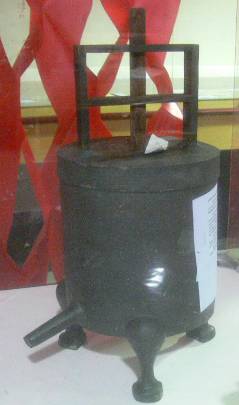The earliest known Chinese water clock, clepsydra was one of the most important timepieces used in ancient China. It was composed of an hourglass and a graduated arrow-shaped rod.
According to the records in Louke Jing (the Canon of Clepsydras), the invention of clepsydra dates back to the legendary Yellow Emperor’s time and became popular during the Xia and Shang dynasties. “The Astronomical Chapter” in the Book of the Sui Dynasty says that “the Yellow Emperor discovered that one could divide a day and a night by observing the dripping water from a crevassed pottery vessel.” From this description we can learn that as far back as five thousand years ago, there were already pottery clepsydras in use in China. The one on display works like this: as water runs out of the small hole in the bottom of the hourglass, the arrow-shaped measuring rod sinks on its float and shows the passage of time by its position.
The original of this clepsydra was excavated in 1968 from a Han tomb located in Mancheng of Hebei Province. It was made before 113BC.

